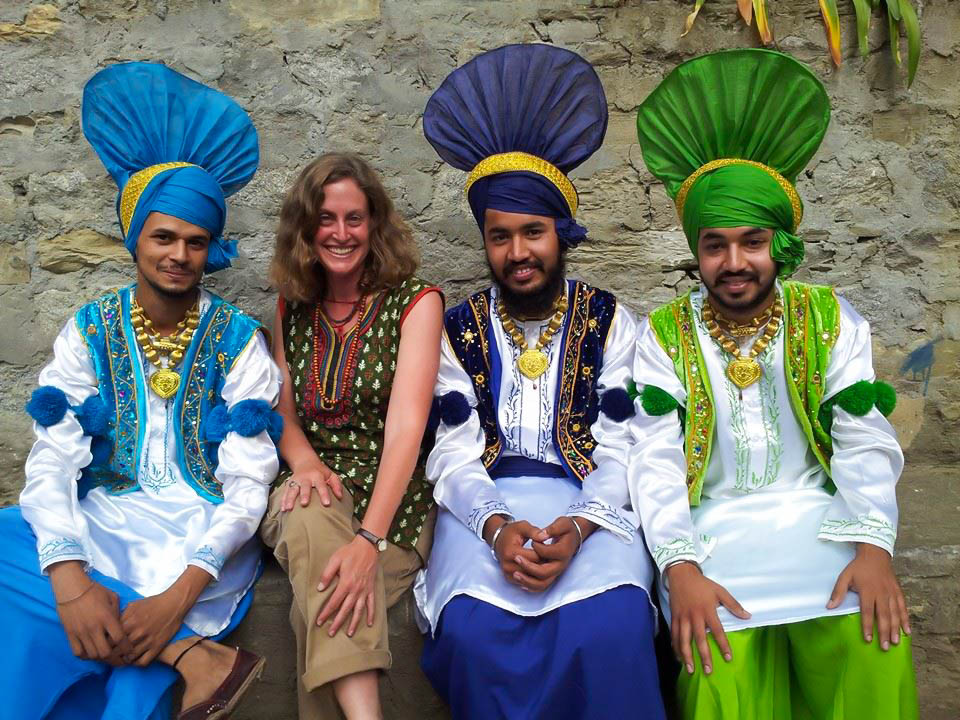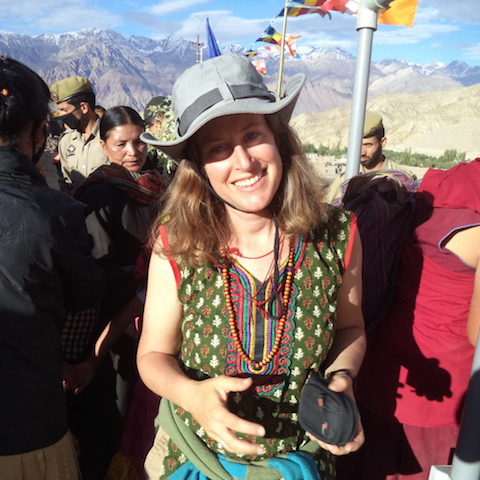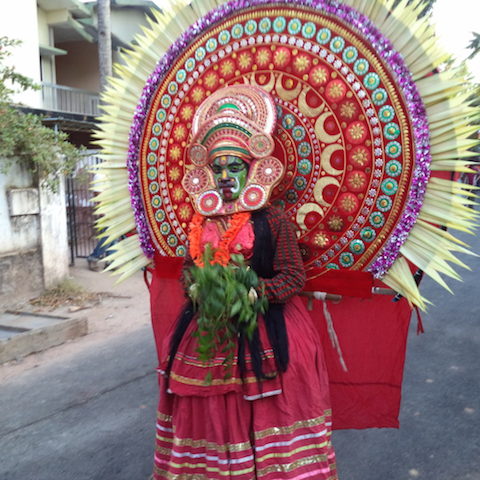A Family Passage to India: In Conversation with Author Dena Moes

Women who love to travel and happen to have kids all too frequently break their lives into ‘the past’ and ‘the future’. The past was when we were younger, freer, with fewer responsibilities and the ability to buy a ticket and take off whenever we pleased. It was when we didn’t have to plan our outings around nap times, pushchair accessibility, or which vehicles will fit a car seat. The future is the time we may look forward to–the time when our kids are grown, when we can regain some of that young independence again, book a trip without worrying about anyone but ourselves.
The present is a time when we, apparently, have to clip those wings. With kids to support, kids who have to go to school and follow a routine and join extracurricular activities, etc etc etc, travel as anything more than a 7-day beach vacation once a year is just impractical, right?
Not according to author Dena Moes, who (with her husband, Adam) took her 11 and 14-year-old daughters out of school for eight months to go backpacking across India and Nepal. Dena’s memoir about the trip, The Buddha Sat Right Here: A Family Odyssey Through India and Nepal is a book that all aspiring family travelers should read. Not only to prove that it can be done, but because it’s great fun, beautifully written, and you might learn a lot about Indian culture and Buddhism along the way.
Dena had always longed to travel to India after hearing her husband’s stories about his travels before they met, but put it in the ‘too hard’ basket when her two daughters were young. She ran a busy midwifery practice in Chico, California, and life was full. But, after an impromptu solo trip to India to visit her sister and new niece in Delhi, she realised that her daughters would benefit from travelling there while they were still children.
Enough was enough: off to South Asia they went.
Yet it was also more than that–Dena herself was on the verge of burnout, exhausted from being her family’s primary income earner, chauffeur, cook, cleaner, and all those other things that women are so used to juggling.
Enough was enough: off to South Asia they went. I recently had the privilege of speaking with Dena about her travels and her memoir, her first book, which has just been published.

Did you plan to write The Buddha Sat Right Here before your travels, or during it, or was it something that emerged afterwards? Did you take notes as you travelled with the intention of turning them into a book?
Our family’s eight month trip to India and Nepal was the fulfillment of my dream. I had longed to visit India for years, and assumed I would have to wait until our children were grown. When we changed our minds and did it right in the middle of raising our daughters Bella and Sophia, I never imagined I would end up writing a book.
I have a BA in literature, and I love to write while traveling. My whole mindset becomes poetic and imaginative when I am in unfamiliar lands, navigating my way through places that are fresh and new to me. I journal religiously, to document not just the locations, but the feelings, and incredible moments, that happen when one is on an adventure, outside the usual routines. I want to be able to look back later and remember the details of things, and how it felt to be there.
When we returned from our journey, and were back in our California college town, people kept asking me, “How was India?” I answered, “Great. Amazing.” Then I felt ridiculous, because how can those words possibly do justice to the gorgeous, fascinating, challenging time we had? I thought, I can only answer that question by writing a book. So I started writing, and the writing became a journey of its own.
I practically cheered when I read the following passage:
“I had been intimidated by the idea of visiting India until I actually got there. After walking the streets of Delhi, riding an overnight train by myself, and using a railway bathroom, my fears had diminished. The overarching feeling in India is of life, not death. The country is teeming with children, thriving even though no one hovers over them with hand sanitizer and baby wipes in case they touch anything.”
This has been exactly my experience too, and I’m pretty allergic to women’s travel writing that focuses on how ‘dangerous’ India is supposed to be. Without wanting to diminish the serious problems that India certainly has regarding women’s rights and safety, I found it extremely refreshing to read this near the beginning of the book.
How do you, personally, feel about those two very conflicting sides of India: the reality that it can be a dangerous place to be a woman, with the equally valid knowledge that India can, in large part, be a very safe place to travel?
The fears I had harbored about India were less about being a woman, than about picturing throngs of sickly, starving people. And when I saw children everywhere, healthy and gorgeous with absurdly thick hair and clear bright eyes, those fears dissipated. Yes, I saw an occasional unwell child or disfigured beggar, but the extent was minimal compared to what I had imagined.
As for women’s issues – that question is very complicated. India has ancient social constructs which we in the West are not used to – the caste system for one, and deeply entrenched gender roles, especially in remote rural areas. But things are changing rapidly for women in India, where womens’ movements are making remarkable progress. I was always treated with respect and felt safe. I feel that traveling with children possibly helped in that respect. People were thrilled to meet an American family, and we were met with friendliness, not hostility, everywhere we went.
Besides, in the United States, one in four women will be sexually assaulted by the time they are 24. One in four! The number is far, far lower in India, although when crimes against women do occur, they are horrific. So when we talk about violence against women, we need to be careful about making assumptions that may not be true. Sexual violence is a problem everywhere.
One thing thing we did to make ourselves less conspicuous, was to buy cotton salwar kameez and shawls to wear. These clothes conformed to the rules of Indian modesty, and were also beautiful and comfortable. We would drape the scarves over our hair when in crowded areas such as train stations, and felt like we looked elegant in the Indian style and also a little disguised. I advise women traveling in India to put away tank tops, leggings, and shorts which are inappropriate in traditional Hindu culture, and wear the local clothes instead.

You divulge some intimate family details. How did/do your family feel about being immortalized in print in this way? Was this a discussion you had before writing the book, or during? How do they like the finished product?
My family has been very supportive of my writing the book. Bella, who was fourteen when we took the trip, gave me her travel diary to use as I saw fit. Between her diary and my journal, I was able to piece together the time-lines and details of all our amazing experiences, which otherwise may have gotten jumbled in my memory. Bella’s diary was so fresh, funny, and fourteen, that I placed excerpts from it directly into the text. These entries add a delightful, contrasting perspective.
Ok – spoiler alert– towards the end of our journey, our marriage imploded and there was a reckoning between Adam and myself. I was originally planning to leave all of that out of the book. Up until that point, there had been so many incredible adventures to share. I thought the book would be a how-to style of book, and we would be an example of a perfect family who did an incredible trip.
But as I wrote, I discovered that our issues were woven into the entire journey, and what happened when I decided I had had enough was incredibly dramatic and made a great story. When I got to the place in my writing where I could either wrap it up and act like I didn’t leave my husband in the remote Himalayas, or dive deep into our rocky terrain, Adam left for a ten-day meditation retreat.
His absence for ten days gave me the mental space to write from the deep recesses of my heart, without having to face him each day. My kids were busy in school, and I lived on coffee, bagels, and wine for ten glorious writing-filled days, in which I wrote the last sixty pages of the book.
When Adam returned, relaxed and serene from his meditation retreat, I disclosed what I had done – put our problems into the book.
When Adam returned, relaxed and serene from his meditation retreat, I disclosed what I had done – put our problems into the book.
“Look”, I said to him. “What I have written gives other people permission to be flawed humans and make mistakes and still do incredible things. That is the message here and it is powerful. See? See?”
He did not see.
Here is what we did.
I made a document with all the difficult scenes between us and had him read it. He had to know what was in there before I sent it out into the world. I told him to give me feedback on each scene. This turned out to be fascinating, because his perception of what happened was completely different from mine! As best I could, I integrated what I heard from him into the narrative, which resulted in a much more balanced rendition of events.
I am not a faultless heroine, Adam is not a Bad Guy. Adam is an airy, intellectual male who would be happy staying in a meditation cave, living with three fierce, fiery alpha females. Together. In one room. For eight months. What could possibly go wrong? Adam and I love each other, and at times have not been very good at it.
But we are learning to love better, which I hope comes through in the book. And he has been incredibly supportive throughout the long process of writing and publishing this book.
I think many women reading your book will relate to the feeling you express repeatedly of shouldering a disproportionate share of the family care. In the book, Adam often disappears, either in a temper or on a whim, leaving you with the girls and feeling resentful. South Asian gender roles are often portrayed as ‘worse’ than those in Western countries, but at several points throughout the book you notice how well supported Indian and Nepali women are. Could you say a little more about this, about the gender roles and behaviours that you observed in India and Nepal that you think ‘we’ could learn from?
What I learned in South Asia is that American mothers are the most isolated mothers in the entire world. In the U.S, mothers grieve the loss of their village, because as Hillary Clinton said, “It takes a village to raise a child.” The problem is, in America, and probably more and more in other countries too, there is no village for our children. Mothers have to be the entire village, and are alone, so very alone.
In South Asia, I never saw mothers alone with children. There was always someone else, an in-law, an auntie, a sister, a friend. Households tend to be multi-generational, with many relatives under one roof. Middle class, upper class, and professional households have domestic help – cooks, housekeepers, and nannies — and this is normal, not just for the 1%. My mind was blown when I saw how common this level of support was.
I was personally so burned out on trying to do everything myself – cook, clean, manage the household, laundry, yard work, not to mention working a paying job too. Which now makes perfect sense – all of that is way more than one or two people can do on their own. It is just not sustainable.
Living with relatives has it’s own set of problems for sure, but for mothers, it creates a whole network of adults raising children, and takes the massive pressure off of one mother and one father to handle everything, the way we do here in the U.S. I realized that the whole project of the nuclear family is rather unnatural, a recent evolution in human society. Women do better in groups, children do better in a pack. I realized that the problems between Adam and I were not just us. They are systemic and our entire culture is mother- and family-unfriendly right from the foundation up.
I realized that the problems between Adam and I were not just us. They are systemic and our entire culture is mother- and family-unfriendly right from the foundation up.
How to fix this? I don’t know. Recognizing the problem as cultural, rather than women blaming themselves (I must not be trying hard enough to make this family work, etc.) is a first step. Co-housing and intentional communities are all experiments in restoring the village in modern America. Re-thinking priorities, simplifying, and lowering expectations are all strategies I suggest to people with young children.

I laughed at the part where you’re on the Poon Hill trek without walking poles, because I did the same trek with a friend who started off skeptical about them as well, then desperately scrounged a stick from a villager after realizing she needed one. How did you prepare for your travels? Guide books? Blogs? Word-of-mouth advice? Specific resources for family travel? A wing and a prayer?
All of the above!
First, my sister who lives in New Delhi enlightened me about the seasons in India – the dry, the hot, and the wet. Using this information, I planned our meanderings to have the best weather in each location. This was a tremendous help in arriving in places at the best time to be there. We often arrived somewhere to hear “You are just in time! The very special blah-de-blah that only happens once a year is about to begin!” This happened so often I almost titled the book Just in Time!
I read a lot of family travel blogs before the trip. These were helpful in some ways, such as basic travel tips for backpacking families, but also discouraging because most globe-trotting families opt to skip India, deciding it is too intense or hard for them. We went to India because our trip was a pilgrimage – to the sacred sites of Buddhism, to the home of the Dalai Lama, to the river Ganges. This made our trip unique, and made India our destination of choice no matter how intense it may be.
A Family Passage to India: In Conversation with Author Dena Moes
I carried my entirely-too-heavy Lonely Planet India in my backpack – to read up on specific details and plan our moves. But the word-of-mouth advice was the best way to discover where we really should go. We used the Lonely Planet to get to general areas and then used word-of-mouth to find the best spots to be/explore within those regions. People we met along the way gave us so many wonderful tips and pieces of advice!
We learned about the Poon Hill Trek in Nepal while on a beach in Kerala. I scribbled the name of it into my journal, and when we got to Nepal we managed to find our way there.
A friend wrote me this note before we left for India:
“My advice-use that book as your last resort.
Let India’s magic and Bhagwan guide you
The planet is not lonely
The inner guidebook is triumphant.”
It’s clear that your daughters gained so much from the eight months you spent in South Asia. But, the trip was several years ago now. How do you think it has affected them as they have grown up? Do you think their interests and future plans have been moulded by their travels while young?
We returned from our Indian sojourn four years ago, and it is clear that our pilgrimage has served as an anchor, a grounding of our lives as American Buddhists. Each of the girls became an emissary of Buddhism in their respective school communities – offering presentations, educating about the Tibetan cause, and clearing up many misconceptions their peers had about Buddhism.
Sophia has used the teachings on compassion and forgiveness very directly, to navigate social difficulties through middle school and now in high school. Bella sat a ten-day Vipassana meditation course with her father just before she left for college. She is studying world sociology at her university, with an eye to global social justice.
In the post-script you say you intended to return to Nepal and India to work in maternal and child health. Do you have a status update on this?
Right now I am busy working in a reproductive health center here in Chico California. Our community is reeling from the Camp Fire, which three months ago completely destroyed the neighboring town of Paradise, ten miles away. All hands are on deck to provide services to folks who have lost everything, including their own doctors, clinics, and hospital. So my focus is very local right now, as we slowly recover from this stunning disaster.
Once Sophia finishes high school in a couple years, all bets of where to find me are off. I have been taking coursework in global health, and following the good news of successful pilot programs currently training nurse-midwives in India. So stay tuned!
Check out Dena’s website, here.
The Buddha Sat Right Here is available on Amazon and, for Australian readers, Angus & Robertson.








